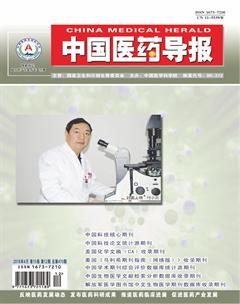细菌中谷胱甘肽的研究进展
李成龙 刘向红 吴也可
[摘要] 谷胱甘肽(GSH)广泛存在于革兰阴性菌和部分革兰阳性菌中,是其中含量最丰富的含巯基小分子肽。部分细菌可在体内直接合成GSH,也有部分细菌可从外界获得GSH。GSH在细菌体内参与代谢中的氧化还原反应,并通过酶促反应维持体内的平衡。而这种平衡在细菌面对生长过程中来自环境和自身代谢所造成的高氧、高渗透压、药物、金属离子等各种变化时,能够直接或间接的发挥抵抗作用。本文将就GSH在细菌中的合成、代谢平衡及主要的作用进行综述。
[关键词] 谷胱甘肽;细菌;稳态;抗氧化
[中图分类号] R446 [文献标识码] A [文章编号] 1673-7210(2018)04(c)-0021-04
Research Progress of Glutathione in Bacteria
LI Chenglong1 LIU Xianghong1 WU Yeke2
1.School of Medicine, University of Electronic Science and Technology, Sichuan Province, Chengdu 610054, China; 2.School of Clinical Medicine, Chengdu University of of TCM, Sichuan Province, Chengdu 610072, China
[Abstract] Glutathione is a small molecule peptide that is one of the most abundant thiols present in gram-negative bacteria and most gram-positive bacteria. Some bacteria can synthesis glutathione directly, some may acquire glutathione form external environment. Bacteria encounter various stress conditions from the environment and their own metabolites, such as oxidative stress, osmotic stress and other stresses coming from chlorine compounds, metal ions and so on. Glutathione can protects the bacterial cells from these stress damage directly or indirectly. This article is to review the synthesis, metabolic balance and main roles of Glutathione in bacteria.
[Key words] Glutathione; Bacteria; Homeostasis; Antioxidant
谷胱甘肽(glutathione ,GSH)廣泛分布于多种生物体内[1]。在细菌领域,主要存在于革兰阴性菌和部分革兰阳性菌中,包括蓝藻细菌和变形菌门[2]。GSH是细菌体内最主要的、含量最丰富的含巯基的小分子肽。1888年首次从酵母中分离出天然型GSH起[3],GSH的研究就没有中断。在1921年,Hopkins第一次将其作为化合物进行了分离,并命名为谷胱甘肽[4];1929年,GSH的三肽结构被证实[5],这为进一步合成并研究GSH的生物作用打下了基础。
GSH在细菌中的分布溶度通常较高,0.1~10 mmol/L不等,但它在细胞内的总量分布却并不均匀。通常情况下,大多数的GSH都分布于细胞质中,含量大约占到了总量的90%[6]。GSH既能通过二硫键的形成来阻止蛋白质的氧化,也能通过作为GPx的底物,抑制脂质的过氧化,从而起到抗氧化的作用[7]。除了抗氧化作用,GSH在细菌细胞内还起了诸多其他作用:例如抵抗渗透压[8]、对细胞内钾离子通道活性调控[9]、对毒性物质的抵抗等[10]。本综述将从GSH在细菌中的生物合成、细胞体内含量的平衡及其在细菌中的主要作用三个方面进行概述。
1 GSH的合成
通常情况下,细菌能够在体内自发的合成GSH,以维持其含量。GSH合成过程可分为两步:
(1)
(2)
GSH的合成过程由ATP水解提供能量,此过程中涉及到了两种酶的催化:γ-谷氨酰半胱氨酸合成酶(γ-glutamate- cysteine ligase,GCS)及谷胱甘肽合酶(glutathione synthetase,GS)[11]。首先,一个谷氨酸分子(L-Glu)和一个半胱氨酸(L-Cys)分子通过GCS催化生成γ-谷氨酰半胱氨酸(γ-Glu-Cys)[12];之后后者与一个甘氨酸分子(Gly)在谷胱甘肽合酶的作用下,结合形成GSH[13]。通常来说,γ-谷氨酰半胱氨酸合成酶和谷胱甘肽合酶分别由gshA基因与gshB基因编码形成[2];但研究发现,在一些革兰阳性菌,如肠球菌、链球菌、李斯特菌等中,虽然细菌缺少GshB基因,却依然能够产生大量的GSH,可能是因为细胞中的γ-谷氨酰半胱氨酸合成酶却可以同时完成两个反应的催化作用,从而使得反应能够正常进行[14]。
2 GSH的代谢
GSH在细菌体内的合成分为两步进行。第一步反应:GCS催化生成γ-谷氨酰半胱氨酸。在其中,GCS的活性与细菌体内GSH的含量构成了一种反馈抑制,同时,细胞内谷氨酸盐的含量对半胱氨酸的浓度有限制作用。第二步反应:GS催化甘氨酸与γ-谷氨酰半胱氨酸结合形成GSH[15]。
正常情況下,GSH在细菌体内浓度的维持,一方面来自于生物合成,一方面还有分解。在GSH中存在巯基,这使得它易于被氧化,例如两个GSH中的巯基氧化形成二硫键,从而转变成为GSSG,但这种氧化是可逆的。此外,目前的研究发现,γ-谷氨酰转肽酶(GGT)能够裂解L-谷氨酸与L-半胱氨酸间的伽马连接,使得分子分解,从而影响到体内GSH的浓度[16]。
目前研究成果中,对于细菌中GSH含量维持的主要机制,依然没有定论。例如,在大肠埃希菌中,GGT是一种周质蛋白酶,当细胞质内的GSH流入细胞周质时,在GGT的作用下被分解[17]。但没有证据显示,这个过程对维持细胞内GSH的浓度有关键作用。事实上,细胞周质中没有确定有GSH的存在,也没有发现GSH是否会出现在细胞周质间隙中。此外,研究人员发现,在缺少GGT的情况下,GSH的体内含量依然会减少,而机制尚不清楚[18]。
3 GSH在细菌中作用
在氧化环境中,GSH能够与其他含巯基蛋白质形成二硫键,此二硫键能够被还原,从而保护了其他蛋白质的生物活性。同时,链端的巯基氧化还原电位极低,这使得它能够优先与体内的活性氧自由基(reactive oxygen species,ROS)结合,从而保护细胞体内的其他组织不受氧化[19]。除开这种抗氧化能力,GSH还具有抵抗渗透压、控制细胞内的钾离子通道活性及包括大多数氯化物在内的毒性物质的解毒功能[20]。
3.1 抗氧化
GSH在发生氧化应激时,能够通过在酶促作用下进行GSH与GSSG的相互转换,或是通过GSH/GPx系统参与氧化还原反应[11]。GSH/GPx系统的主要组成部分包括与GSH合成相关的两种酶:GCS、GS,以及谷胱甘肽还原酶(GR)、谷胱甘肽过氧化物酶(GPx)和还原型辅酶Ⅱ(triphosphopyridine nucleotide,NADPH)[21]。这个系统能够直接清除细胞内多余的自由基。当细胞内ROS过多,如生成少量H2O2时,GSH在GPx的作用下,把H2O2还原成H2O,其自身被氧化为GSSG,GSSG在GR作用下,接受H被还原成GSH,使体内自由基的清除反应能够持续进行[22]。在一项研究中,研究人员萃取了乳酸乳球菌乳脂亚种进行了培育实验;试验中发现在具有充足氧气条件下培养的细菌比无氧条件下培养的细菌GSH的积累量高了30%,而谷胱甘肽过氧化物酶(GPx)得活性高了5倍[23],这为GSH/GPx系统的抗氧化作用提供了直接证据。
3.2 抵抗渗透压
研究表明,GSH能够调控细菌细胞内钾离子的输运通道,这对于维持细胞内渗透势有重要作用。在大肠埃希菌中,钾离子输出通道的控制基因为KefB及KefC,它们受到GSH的抑制[24],当细胞内缺少GSH时,钾离子的流失速度将会加快,这表明GSH是钾离子输出通道的闸门[25],相同的结果也表现在其他革兰阴性菌中。此外,在细胞质中的GSH分子是带负电荷的,当钾离子大量积累时,GSH的积累能够与钾离子形成电荷对,从而维持细胞体内的电荷平衡[26]。在高渗透压环境下细胞内还可能伴随有氧化应激的出现,比如大肠埃希菌在高渗透压的环境中将会减少SodA与SodB的表达,这将使得细胞体内的氧活性自由基增多,此时GSH的积累将有助于维持氧化还原的平衡,间接的维持渗透压浓度[27]。
3.3 抗毒性
GSH参与解毒过程的常见方式是通过酶促反应与有害物质的亲电子基团发生巯基偶联,这种结合可以增加其分子的疏水性,这将使得反应产物能够较容易的穿越细胞膜,分解后排出体外,从而达到解毒的目的[28]。催化这种反应进行的一类酶被称为谷胱甘肽硫转移酶(glutathione S-transferases,GSTs),它能催化GSH的巯基与一些亲电子类物质结合,这些物质主要包括过氧化物、不饱和醛酮、烷基或芳香基化合物等。除了酶促反应外,GSH也会与某些氯化物直接反应,并生产低毒性物质排除体外,起到解毒的作用。在大肠埃希菌中,GSH能通过直接与次氯酸(HClO)或是氯化铵(NH4Cl)等氯化物直接反应,生成无害的物质并排出体外,从而起到解毒的作用[29]。也有研究发现,GSH对部分重金属离子也有抵抗作用,细菌暴露于氯化汞(HgCl2)环境中时,若维持一定的抵抗作用,则其谷胱甘肽还原酶的活性的与GSH的合成速率均增长为正常值的2倍[30]。
综上所述,本文围绕GSH在细菌中的主要作用对近年来GSH在细菌中的研究进行了综述,分别从抗氧化、抗渗透压和抗毒性出发,概述了对GSH作用机制的研究。这些研究结果提供了许多有关GSH在细菌中所起主要作用的证据,其现象帮助人们更好地认识了细菌及其内GSH的代谢,也为研究者提供了更多利用应激制取GSH的思路。
[参考文献]
[1] Bathige SD,Umasuthan N,Godahewa GI,et al. Two variants of selenium-dependent glutathione peroxidase from the disk abalone Haliotis discus discus:Molecular characterization and immune responses to bacterial and viral stresses [J]. Fish Shellfish Immunol,2015,45(2):648-655.
[2] Narainsamy K,Farci S,Braun E,et al. Oxidative-stress detoxification and signalling in cyanobacteria: the crucial glutathione synthesis pathway supports the production of ergothioneine and ophthalmate [J]. Mol Microbiol,2016, 100(1):15-24.
[3] Gutierrez-Praena D,Pichardo S,Jos A,et al. Alterations observed in the endothelial HUVEC cell line exposed to pure Cylindrospermopsin [J]. Chemosphere,2012,89(9):1151-1160.
[4] Hopkinson RJ,Leung IK,Smart TJ,et al. Studies on the Glutathione-Dependent Formaldehyde-Activating Enzyme from Paracoccus denitrificans [J]. PLoS One,2015,10(12):e0145085.
[5] Kumar S,Kasturia N,Sharma A,et al. Redox-dependent stability of the gamma-glutamylcysteine synthetase enzyme of Escherichia coli:a novel means of redox regulation [J]. Biochem J,2013,449(3):783-794.
[6] Lim B,Pasternak M,Meyer AJ,et al. Restricting glutamylcysteine synthetase activity to the cytosol or glutathione biosynthesis to the plastid is sufficient for normal plant development and stress tolerance [J]. Plant Biol (Stuttg),2014,16(1):58-67.
[7] Yang Y,Wang W,Huang T,et al. Transgenesis of Tol2-mediated seamlessly constructed BAC mammary gland expression vectors in Mus musculus [J]. J Biotechnol,2016, 218(3):66-72.
[8] Xu Z,Xie J,Liu J,et al. Whole-genome resequencing of Bacillus cereus and expression of genes functioning in sodium chloride stress [J]. Microb Pathog,2017,104(6):248-253.
[9] Chauhan AK,Kang SC. Thymol disrupts the membrane integrity of Salmonella ser. typhimurium in vitro and recovers infected macrophages from oxidative stress in an ex vivo model [J]. Res Microbiol,2014,165(7):559-565.
[10] Krishna G,Gopalakrishnan G,Goel S. In vitro and in vivo genotoxicity assessment of the dopamine receptor antagonist molindone hydrochloride [J]. Environ Mol Mutagen,2016,57(4):288-298.
[11] Guzman-Guillen R,Prieto Ortega AI,Martin-Camean A,et al. Beneficial effects of vitamin E supplementation against the oxidative stress on Cylindrospermopsin-exposed tilapia(Oreochromis niloticus)[J]. Toxicon,2015,104(3):34-42.
[12] Stout J,De Vos D,Vergauwen B,et al. Glutathione biosynthesis in bacteria by bifunctional GshF is driven by a mod?鄄ular structure featuring a novel hybrid ATP-grasp fold [J]. J Mol Biol,2012,416(4):486-494.
[13] Kadiyala M,Ponnusankar S,Elango K. Calotropis gigantiea (L.) R. Br(Apocynaceae):a phytochemical and pharmacological review [J]. J Ethnopharmacol,2013,150(1):32-50.
[14] Lu D,Tang G,Wang D,et al. The Sinorhizobium meliloti LysR family transcriptional factor LsrB is involved in regulation of glutathione biosynthesis [J]. Acta Biochim Biophys Sin (Shanghai),2013,45(10)):882-888.
[15] Guzman-Guillen R,Prieto AI,Vazquez CM,et al. The pro?鄄tective role of l-carnitine against cylindrospermopsin-induced oxidative stress in tilapia (Oreochromis niloticus)[J]. Aquat Toxicol,2013,132(3):141-150.
[16] Lee EH,Kim HY,Hwang KY. The GSH- and GSSG-bound structures of glutaredoxin from Clostridium oremlandii [J]. Arch Biochem Biophys,2014,564(4):20-25.
[17] Zhang J,Quan C,Wang C,et al. Systematic manipulation of glutathione metabolism in Escherichia coli for improved glutathione production [J]. Microb Cell Fact,2016,15(4):31-38.
[18] van der Stel AX,van Mourik A,Laniewski P,et al. The Campylobacter jejuni RacRS two-component system activates the glutamate synthesis by directly upregulating gamma-glutamyltranspeptidase(GGT)[J]. Front Microbiol,2015,345(6):561-567.
[19] Chen F,Gao J,Wu D,et al. Clinical and pathologic features of a suspected selenium deficiency in captive plains zebras [J]. Biol Trace Elem Res,2017,176(1):114-119.
[20] Kirankumar B,Kulkarni GB,Sanjeevkumar S,et al. Influence of DMF-induced oxidative stress on membrane and periplasmic proteins in Paracoccus sp. SKG [J]. Appl Biochem Biotechnol,2014,173(5):1263-1273.
[21] Lu J,Holmgren A. The thioredoxin antioxidant system [J]. Free Radic Biol Med,2014,66(3):75-87.
[22] Wang D,Zhu F,Wang Q,et al. Disrupting ROS-protection mechanism allows hydrogen peroxide to accumulate and oxidize Sb(Ⅲ) to Sb(Ⅴ) in Pseudomonas stutzeri TS44 [J]. BMC Microbiol,2016,16(1):274-279.
[23] Fu RY,Bongers RS,van S,et al. Introducing glutathione biosynthetic capability into Lactococcus lactis subsp. cremoris NZ9000 improves the oxidative-stress resistance of the host [J]. Metab Eng,2006,8(6):662-671.
[24] Fujisawa M,Ito M,Krulwich TA. Three two-component transporters with channel-like properties have monovalent cation/proton antiport activity [J]. Proc Natl Acad Sci USA,2007,104(33):13289-13294.
[25] Healy J,Ekkerman S,Pliotas C,et al. Understanding the structural requirements for activators of the Kef bacterial potassium efflux system [J]. Biochemistry,2014,53(12):1982-1992.
[26] Iantomasi T,Favilli F,Vincenzini MT. Evidence of glutathione transporter in rat brain synaptosomal membrane vesicles [J]. Neurochem Int,1999,34(6):509-516.
[27] Dhar MS,Gupta V,Virdi JS. Detection,distribution and characterization of novel superoxide dismutases from Yersinia enterocolitica Biovar 1A [J]. PLoS One,2013,8(5):e63919.
[28] Carneiro M,Reis B,Azevedo J,et al. Glutathione Transferases responses induced by microcystin-lr in the gills and hepatopancreas of the clam venerupis philippinarum [J]. Toxins(Basel),2015,7(6):2096-2120.
[29] Lemke LS,Chura-Chambi RM,Rodrigues D,et al. Investigation on solubilization protocols in the refolding of the thioredoxin TsnC from Xylella fastidiosa by high hydrostatic pressure approach [J]. Protein Expr Purif,2015, 106(3):72-77.
[30] Zhang W,Yin K,Li B,et al. A glutathione S-transferase from Proteus mirabilis involved in heavy metal resistance and its potential application in removal of Hg2+ [J]. J Hazard Mater,2013,261(2):646-652.
(收稿日期:2017-12-26 本文編辑:苏 畅)

